 |
 |
 |
| |
AIDS-Defining Conditions (ADCs) in the BENCHMRK -1 and -2 Trials: 48 Week Analysis
|
| |
| |
Reported by Jules Levin
48th ICAAC/46th IDSA Annual Meeting
October 25-28, 2008
Washington, DC
1Eron JE, 2Nguyen B-Y, 3Steigbigel RT, 4Cooper DA, 2Rhodes RR, 2Meibohm A, 2Zhao J, 2Isaacs RD, 2Teppler H for BENCHMRK-1 and -2 Team
1University of North Carolina at Chapel Hill, 2Merck Research Laboratories, 3State University of New York at Stony Brook, 4University of New South Wales
Copyright © 2008 Merck & Co., Inc., Whitehouse Station, New Jersey, USA, All Rights Reserved
From Jules: it is of particular note, although not unexpected, that baseline CD4 count and viral load at both baseline and after 16 weeks of therapy appear associated with the development of AIDS defining events and death.
Author Conclusions
In the BENCHMRK studies, the rates of clinical endpoints occurring during the double-blind phase were lower for raltegravir compared with placebo at week 48, regardless of endpoint. These differences did not reach statistical significance.
Esophageal candidiasis was the most frequent ADC in both treatment groups.
Advanced disease (low CD4 counts, high HIV RNA levels, and previous ADC) rather than treatment history or GSS appeared to be associated with disease progression and/or death.
Patients who experienced an ADC or died showed lower responses for HIV RNA suppression and smaller CD4 cell increases than patients who did not.
The BENCHMRK studies are ongoing and will provide an opportunity for further analysis at time points beyond week 48.
ABSTRACT
Background: Two phase III trials (BENCHMRK-1 and -2) of the integrase inhibitor raltegravir (RAL) (400 mg bid) vs. placebo (PBO), plus optimized background therapy (OBT), in highly treatment experienced patients failing other antiretroviral therapies were analyzed through 48 weeks of double-blind
treatment; primary endpoint was HIV RNA. Although not designed to detect significant differences in development of ADCs, a meta-analysis was done to evaluate their occurrence.
Methods: All new or recurrent clinical ADCs (excluding CD4 < 200/μL) identified by investigators or study personnel were reviewed by an independent adjudicator not involved in the trials and blinded to treatment assignment, for determination
whether the event met prespecifi ed criteria for a confirmed ADC. Confirmed ADCs included definitive and presumptive diagnoses, according to established conventions. Results are shown as incidence rate per 100 patient-years (PYR) at risk.
Results: At entry, patients had advanced disease; 293/462 (63%) and 165/237 (70%) of the RAL and PBO groups had a previous clinical ADC and median CD4 counts were 119 and 123 cells/μL, respectively. At wk 48, 62% and 33% of patients in the RAL vs. PBO groups achieved HIV RNA <50 copies/mL. 17/462 pts treated with RAL had at least 1 confirmed ADC compared with 11/237 treated with PBO. The incidence rates per 100 PYR were 3.7 for RAL and 6.2 for PBO. The RR (95% CI) was 0.6 (0.3, 1.4). The most common ADC in both groups
was esophageal candidiasis. The median (IQR) time to onset of the ADC was 64 (50-122) and 105 (19-118) days for RAL and PBO groups, respectively.
Conclusion: The incidence rate of confirmed ADCs was numerically lower for RAL compared with PBO at Week 48, though not statistically significant.
Background
AIDS-Defining Conditions (ADCs)
Early large randomized comparative trials of highly active antiretroviral therapy (HAART) compared protease inhibitors (PI) to placebo either added to ongoing nucleoside therapy (1) or in combination with 2 nucleoside reverse transcriptase
inhibitors in patients naïve to therapy or experienced only with monotherapy (2)
-- A significant reduction in AIDS-defining conditions and death was observed for the PI-containing regimens.
Changes in HIV RNA and CD4 were established as adequate surrogates for the serious clinical endpoints.
-- HIV viral load shown to be predictive of death in patients with HIV infection (3)
-- Subsequent trials in the HAART era relied on comparisons of these surrogate markers
-- Combination therapies with similar or greater responses in viral load and CD4 cell counts rarely, if ever, demonstrated improvement in AIDS-defining conditions or death.
With the development of potent agents in novel or existing classes active against highly drug-resistant variants, substantial improvements in efficacy as measured by viral load and CD4 responses were observed when these agents were combined with optimized therapy in comparison to optimized therapy plus placebo.
The Phase III BENCHMRK studies (4) offered an opportunity to assess ADC rates during treatment with raltegravir, the first licensed agent in a new class of antiretrovirals (integrase inhibitors), in highly treatment experienced patients.
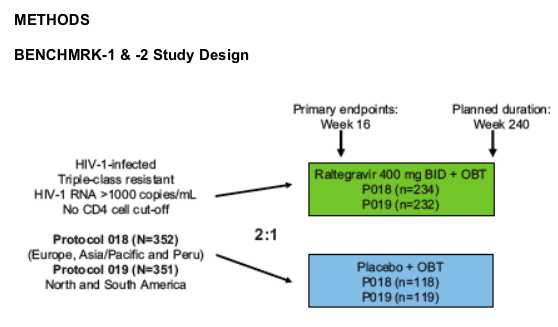
Randomized, double-blind, placebo-controlled with Data and Safety Monitoring Board
Primary analysis at Week 16; secondary analysis at Week 48
OBT was selected by investigator based on baseline resistance testing and prior treatment history. Selected investigational ARTs, darunavir and tipranavir, were permitted.
Patients meeting prespecified criteria for virologic failure after ≥16 weeks could enter an open-label postvirologic failure (OLPVF) phase to receive raltegravir. Patients and investigators remained blinded to initial therapy assignment.
Primary and secondary endpoints:
-- Suppression of HIV RNA < 400 and < 50 copies/mL
-- Change from baseline in CD4 cell counts
Analysis of AIDS-Defining Conditions
Occurrence of ADCs was prespecified as an exploratory endpoint
Adjudication process
External independent adjudicator reviewed blinded data for each suspect ADC from both double-blind and OLPVF phases and characterized the event as definitive ADC, presumptive ADC, or not ADC based on prespecified criteria
-- 1993 CDC Revised Classification System for HIV Infection and Expanded Surveillance Case Definition for AIDS among adolescents and adults and
-- AIDS-Defining Conditions used in ACTG (AIDS Clinical Trials Group) Trials Protocol A5175.
All deaths were reviewed for possible presence of ADC.
Clinical Endpoints
Confirmed ADCs included both defi nitive and presumptive diagnoses
Although the investigators indicated the possible association of several ADCs with immune reconstitution syndrome, all ADCs were included in the analyses.
Double-blind phase
- New and recurrent ADCs (prespecifi ed)
- New ADCs only
- Deaths - all cause mortality
- All ADCs (new and recurrent) or death
- New ADC or death
Sensitivity analyses: all ADCs and deaths occurring during the double-blind and OLPVF phase.
Statistical analyses
Exposure-adjusted event rates (number of patients with endpoint/person-years of follow-up) were calculated to account for
-- 2:1 randomization
-- Longer follow-up in double-blind phase for raltegravir group due to larger number of virologic failures in the placebo group (median 57 vs 38 weeks).
Kaplan Meier plots of time to endpoint
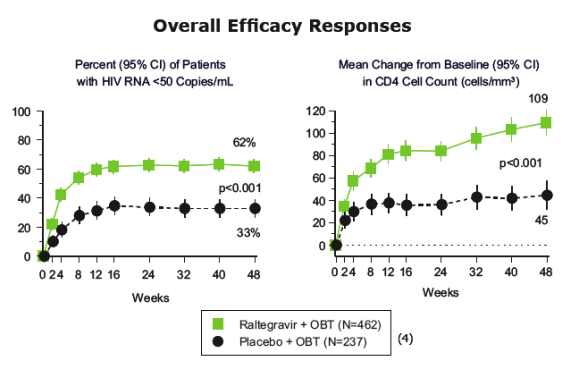
ADCs and Deaths during Double-Blind Phase
17 raltegravir (3.7%) and 11 placebo (4.6%) patients had at least one confirmed ADC (new or recurrent)
-- 5 patients in each group had 2 ADC
-- Total of 22 ADCs in the raltegravir group and 16 in the placebo group;
New ADCs occurred in 7 (1.5%) raltegravir and 6 (2.5%) placebo patients.
-- Total of 8 new ADCs in each group
10 raltegravir (2.2%) and 6 placebo (2.5%) patients died
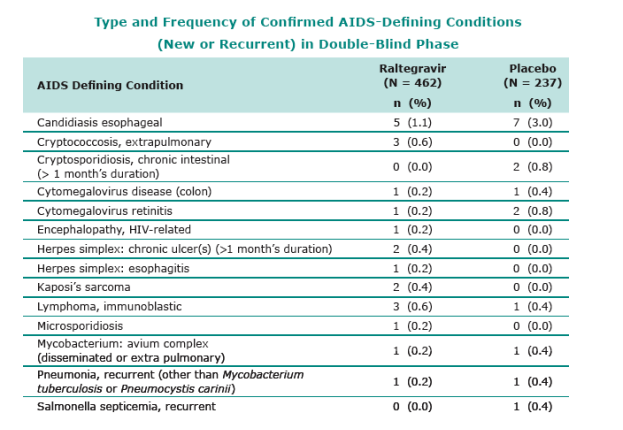
Raltegravir and Placebo were administered with Optimized Background Therapy (OBT).
Patients with multiple events may be counted more than once if they had multiple ADC diagnoses.
Confirmed ADC = presumptive or definitive per SOP.
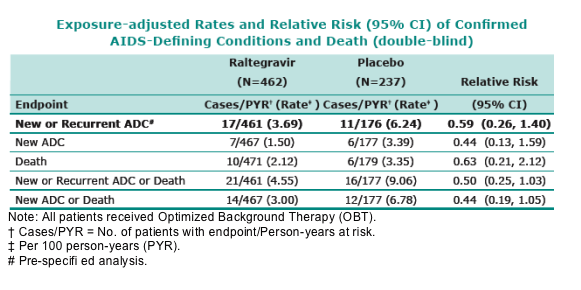
The risk of each endpoint was lower in the raltegravir group than in the placebo group.
The confidence intervals for the RR include 1 indicating the differences between the groups were not statistically significant.
Time to first new or recurrent ADC [median (25th - 75th percentile)]
-- Raltegravir: 9.1 weeks (7.4 - 15.7)
-- Placebo: 15.0 weeks (2.7 - 16.9)
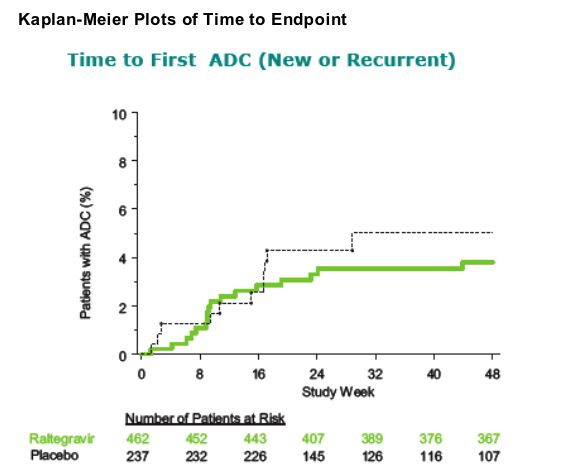
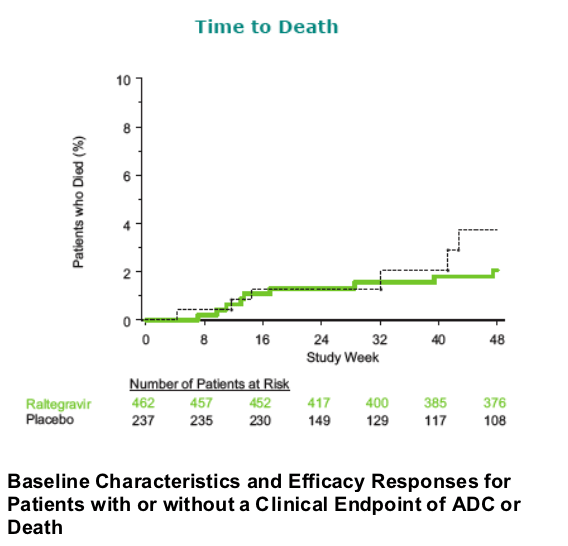
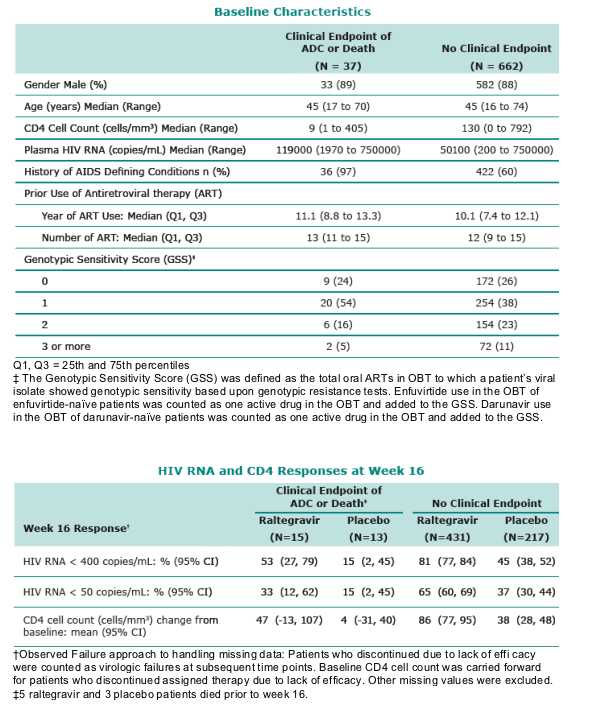
Compared to patients without an event, patients who had an ADC or died had
-- Lower baseline CD4 cell counts
-- Higher baseline viral RNA levels
-- More frequent history of previous ADC
Baseline characteristics were similar for raltegravir and placebo within these subgroups (data not shown)
Virologic and immunologic responses were lower for patients who experienced an endpoint than for those who did not in both treatment groups
References
1. Cameron DW, Heath-Chiozzi M, Danner S, et al. Randomized placebo-controlled trial of ritonavir in advanced HIV-1 disease. The Advanced HIV Disease Ritonavir Study Group. Lancet. Feb 21 1998;351(9102):543-549.
2. Hammer SM, Squires KE, Hughes MD, et al. A controlled trial of two nucleoside analogues plus indinavir in persons with human immunodefi ciency virus infection and CD4 cell counts of 200 per cubic millimeter or less. AIDS Clinical Trials Group 320 Study Team. N Engl J Med. Sep 11 1997;337(11):725-733.
3. Mellors JW, Rinaldo CR, Jr., Gupta P, White RM, Todd JA, Kingsley LA. Prognosis in HIV-1 infection predicted by the quantity of virus in plasma. Science. May 24 1996;272(5265):1167-1170.
4. Steigbigel RT, Cooper DA, Kumar PN, et al. Raltegravir with optimized background therapy for resistant HIV-1 infection. N Engl J Med. Jul 24 2008;359(4):339-354.
|
| |
|
 |
 |
|
|